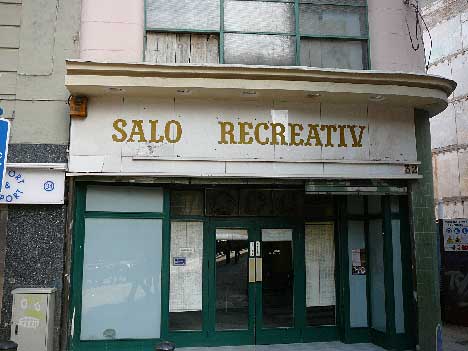The manager of this distinctly non-Bond den of one-armed banditry in Calle del Hospital, Barcelona subscribes to the commonly-held opinion that illegal Spanish signs can be turned into legal Catalan ones simply by removing the last letter of each word. In his case, SALON RECREATIVO -> SALO RECREATIV. One hopes the spelling police will take a relaxed view re the substitution of u by v (in medieval English generally only permissible in initial position; what’s the case for Lemosin dialects?) and read the corrected version as SALÓ RECREATIU.
There’s a nice example of this kind of thing driven by consumer pressure rather than language police fines in the issue of the Barcelona journal Mirador, Setmanari de Literatura, Art i Política for October 22 1931. The writer comes across a Barcelona haberdashery with the sign MERÇERIA–puzzling, since MERCERIA is correct in both Spanish and Catalan. Enquiries are made inside and it turns out that the boss has added the cedilla knowing that it is incorrect in order to demonstrate that the sign is in Catalan (which uses this diacritic) rather than Spanish (which doesn’t).
Similar posts
- c(h)/qu => k and early/mobile spanish/italian writing
Tearing myself away from puffing the undoubted pleasures of wines of the Penedès for a moment, I would point out that - Linguistic self-hate
David Millán notes that while autoodiar appears in neither the Spanish nor the Catalan standard dictionaries, it forms part of the - “Catalan on the road to extinction”
More panic-mongering from the linguacrats: Carme Junyent, director of the low-activity Group for the Study of Threatened Languages at Barcelona University - Who’s afraid of the big bad Wolof?
I once read some complete nonsense by UCD prof Clarence Major, so I do kind of wonder whether he’s got any - Notes on Franfurk
German sausages commonly arouse Spanish bar owners to orthographical orgasm, but this is perhaps the most beautiful, and at first sight


Ola
I’ve only just discovered your blog. I can’t find the thread from 2006 about language traitors operating inside TV3, identified as Grup d’Estudis Catalans. Any news about these mischievous worms, or have they been exterminated?
http://oreneta.com/kalebeul/2006/02/26/traitors-to-the-language/